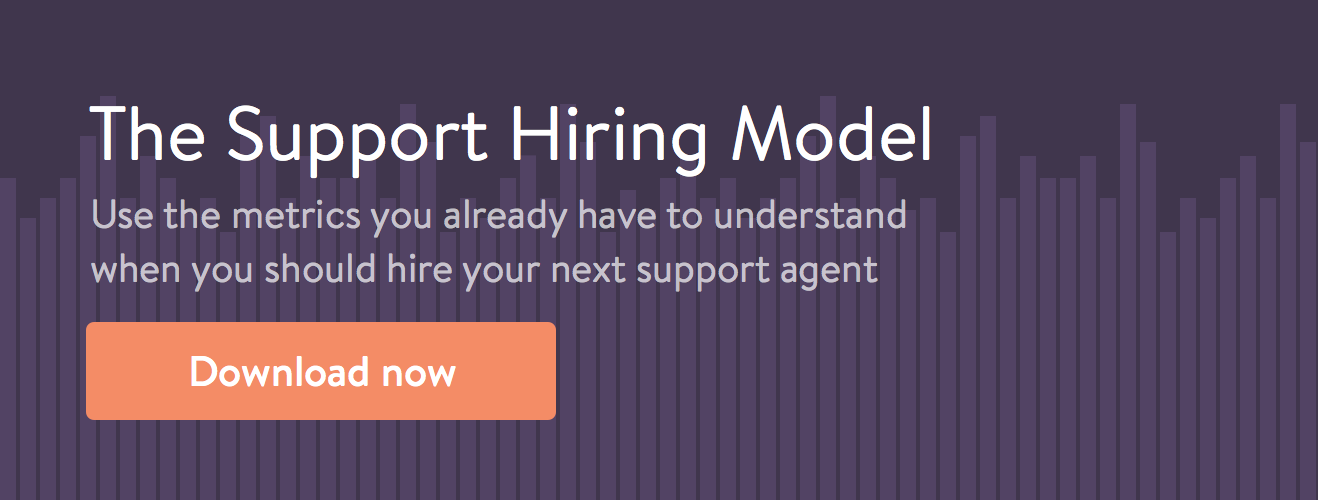Scaling up your customer support team means you not only need to hire more staff to handle the increase in volume, but you’ll also want to measure performance and results from your current team, to ensure they’re working efficiently and to their full potential.
Speed is easy to manage and measure. So, a lot of managers tend to default to only using this, to track how long it takes for a team member to respond to a customer enquiry, also known as average handle time (AHT).
AHT is important, but putting pressure on this metric will only show negative results from both your customers and support team. Here’s what to avoid when using AHT to measure your support team’s performance:
1. Avoid incentivising the number of tickets they respond to
These competitions are never fair due to certain members having commitments outside of the support queue and will only lead to negativity across the team.
2. Avoid publicly rewarding fast ticket responses
Be careful rewarding members of your team who respond to tickets the fastest, without looking into how they’re actually responding. The rest of your team will find ways to speed up their own process by ‘cherry picking’ easy tickets or delivering less care to the tickets that needs extra attention. Those tickets that need extra care will end up with lower quality responses and will affect your retention rate.
3. Avoid penalising longer response times
Be especially aware of whether team members are resolving the issue within the first response. If a team member feels they’re behind on their AHT, they will rush their responses. Rushed responses lead to silly mistakes, and those mistakes lead to churn.
Speed isn’t everything and even if your support team are meeting your targets, it doesn’t mean they’re delivering outstanding customer support. In fact, customer experience impact reports indicate that 55% of people have stopped using a service because their issues were not being responded to quick enough, yet 73% have stopped using a service due to rudeness from staff.
So, what else should you be measuring to help scale up your support team?
Trends
Your goal when scaling a support team should be to maintain customer happiness by reducing the amount of volume you’re receiving. To do this, you need to identify why your customers are reaching out, and counteract the most popular problems with an action, to prevent the question in the first place.
As the head of customer support at Hubble, instead of focusing solely on the number of tickets responded to, I focus on feedback. Reducing the number of enquiries received, by spotting trends and communicating this to the development team each week in a Product Feedback Loop meeting. This is where I feed back the most popular problems and feedback from the previous week and communicate each item as a story to why it’s important.
For example:
“Last week 3 different customers reached out about the photo upload step within the signup process. We highlighted last month that we wanted to increase the number of photos on the site to help convert traffic, so I feel this is important.”
Have your team keep track of the most popular tickets they receive and why they’re being asked in the first place by having them tag each issue with a reason why the customer reached out. Record the end result in a task management tool you use regularly. I use Asana, because this is the tool we use to communicate our weekly progress, so it helps keep everything in the same place.
This helps identify common problems that your customers are facing with the product, and pro-actively reaching out to you about. Use the data your team has collected to communicate this to the development team, or, if an edit to the product is not needed, think about creating a FAQ article to help those customers.
First contact resolution:
Sometimes there are questions you’re always going to get, no matter how hard you’ve tried to help make it easy for the customer. So, with these, measure your team’s performance by the number of tickets that were solved within the first response, also known as first contact resolution (FCR).
One technique to achieve a great FCR score to think about the questions you would usually ask the customer and offer an answer for each scenario within your first response.
Try using an example ticket session with your team:
- Ask them the initial questions they would ask as a first response and write them in the ticket
- Now, ask them what answers they would give based on the response from the customer, write these underneath each of the questions
- Highlight to them that if they include the questions and answers in their very first response, they would solve these common tickets with one touch
This will encourage your team to focus on how to solve the customer’s issue, rather than how to just respond to the ticket to get it out of the queue. Helping to reduce volume due to them now being able to tackle other tickets, and helping the customer with an incredibly efficient first response.
Measuring your customer support team’s performance should be based on the original goal, and this is achieved by reducing the number of points at which a customer has to contact your support team about and identifying why they reached out in the first place.
Introducing a simple proxy such as AHT to measure your team’s performance will result in you spending more time on improving the proxy, rather than the original goal.
As my favourite quote from Seth Godin goes: “Gaming the system is never the goal. The goal is the goal.”<